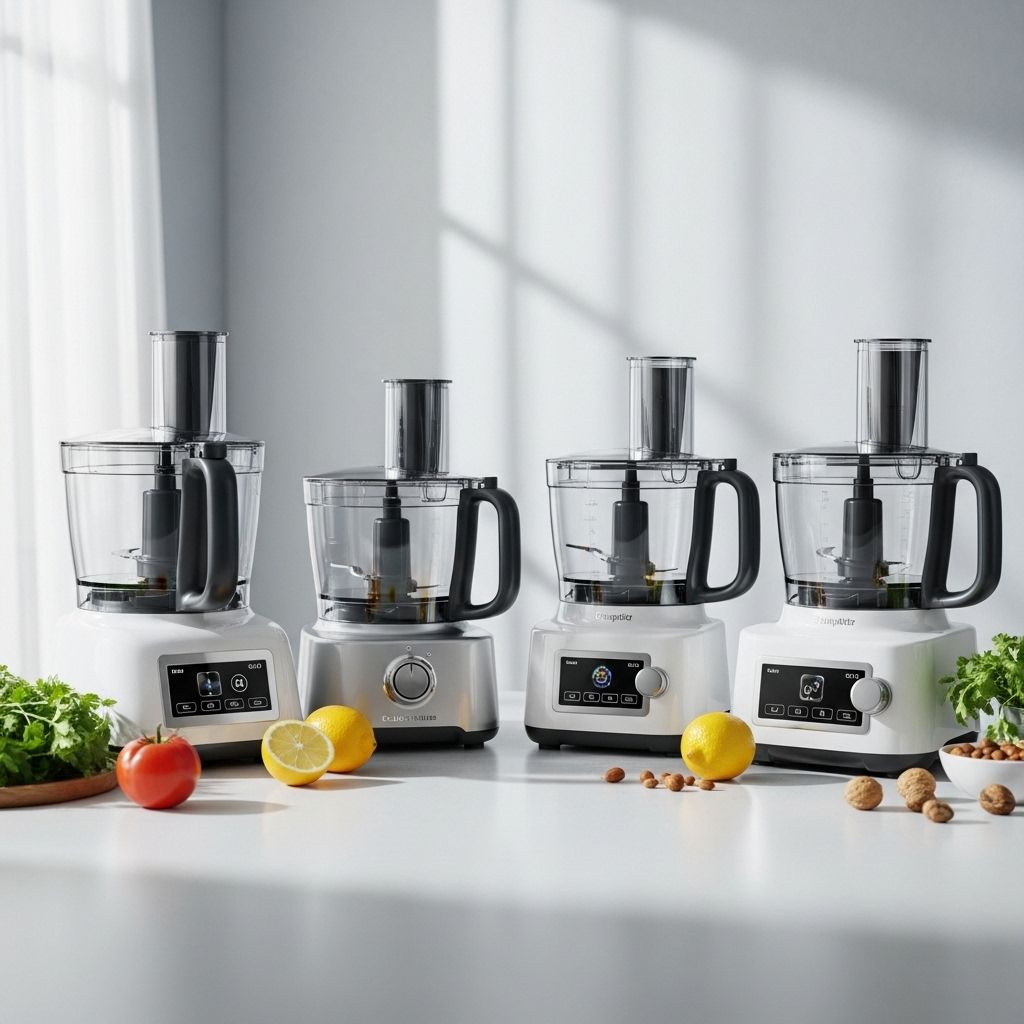The Best Food Processors: Detailed Reviews, Buying Guide, and Use Cases
Real-world tests spotlight models that save prep time and deliver consistent results.

The Best Food Processors: Comprehensive Reviews and Guide
Food processors are indispensable kitchen appliances, offering unparalleled versatility for slicing, dicing, shredding, mixing, and pureeing a wide array of ingredients. The right model can save time, elevate recipes, and streamline meal prep for cooks of all skill levels. In this guide, we dive deep into rigorous hands-on tests, compare top picks, break down performance features, and answer frequently asked questions, so you can select the best food processor to fit your kitchen.
Why You Need a Food Processor
From prepping vegetables for salads to crafting doughs, dips, and nut butters, food processors are culinary workhorses. If you value efficiency and multi-functionality in your kitchen, a food processor can replace tedious manual chopping and blending with the press of a button.
- Time saving: Rapidly chops, shreds, and slices ingredients.
- Consistency: Produces uniform cuts, improving presentation and cook times.
- Versatility: Handles tasks from pureeing to kneading dough.
- Convenience: Large capacities suit big batches; attachments expand functionality.
How We Tested
Each food processor was evaluated for motor power, blade sharpness, attachment versatility, ease of cleaning, capacity, and real-world performance. We ran tests for common applications like slicing onions, shredding carrots, making hummus, and pureeing soup, alongside stress tests using hard ingredients such as nuts and dough. Devices were scored for both speed and quality of results, as well as user experience factors like assembly, stability, and noise levels.
- Performance: How well does it chop, shred, and puree?
- Capacity: Does the bowl accommodate family-sized recipes?
- Versatility: Are the included discs and blades up to any job?
- Ease of Use: Is the interface intuitive? How easy is cleanup?
The Best Food Processors of 2025
Below we break down our top picks, highlighting strengths, limitations, and who each model is best suited for.
| Model | Capacity | Motor Power | Best For | Notable Features |
|---|---|---|---|---|
| Cuisinart 7 Cup Food Processor | 7 Cups | 600 Watts | Everyday meal prep | Classic design, strong base, versatile blades |
| Hamilton Beach 10 Cup Processor | 10 Cups | 450 Watts | Large-batch and family meals | Bowl scraper, oversized feed tube, easy cleaning |
| Kitchenaid 9 Cup Processor | 9 Cups | ExactSlice dial | Precision slicing | Multi-speed, compact design |
| Breville Sous Chef 12 | 12 Cups | 1200 Watts | Heavy-duty, advanced prep | Multiple discs, safety features |
Cuisinart 7 Cup Food Processor
The Cuisinart 7 Cup is a beloved kitchen staple featuring robust construction and straightforward controls. It’s ideal for consistent processing of vegetables, cheeses, doughs, and dips. While it lacks some of the more advanced settings and additional blades found in pricier models, its performance and reliability stand out for most everyday cooking tasks.
- Strong motor easily handles tough jobs.
- Easy-to-clean bowl and attachments.
- Simple interface with single speed, plus pulse.
Hamilton Beach 10 Cup Processor
Known for its powerful 450 W motor and generous bowl size, the Hamilton Beach offers great value for busy kitchens. The bowl scraper attachment is a major convenience, ensuring even processing without stopping to scrape the sides. Its sturdy design accommodates copious quantities for potlucks and family dinners.
- Great for slicing, shredding, and pureeing in large volumes.
- Oversized feed chute shortens pre-processing time.
- Budget-friendly with essential attachments.
Kitchenaid 9 Cup Processor
Kitchenaid’s 9 Cup model stands out for its ExactSlice technology, enabling precise thickness for slices. Multiple speed options and a compact footprint make it helpful for small kitchens needing flexibility. It excels at producing evenly cut vegetables and can tackle doughs with reasonable efficiency.
- Adjustable slice thickness for presentation.
- Compact storage.
- Easy to assemble and clean.
Breville Sous Chef 12
Breville brings professional-level power with its Sous Chef series, boasting a commanding 1200 W motor and one of the largest capacities among home models. Multiple disc and blade options let you tackle tasks from julienne to kneading. Safety features include a locking system, and sturdy construction means long-term durability.
- Handles everything from hard root vegetables to nut butters.
- Wide feed chute fits whole produce.
- Best for batch prepping or entertaining.
Food Processor Buying Guide
Selecting the ideal food processor means matching your cooking style with the features that matter most.
- Capacity: 7-10 cups suits most households; larger models serve batch prepping.
- Motor Power: 400W+ desirable for tough jobs and dough kneading.
- Attachments: Slicing/shredding discs, dough blades, bowl scrapers increase utility.
- Feed Tube Size: A wide tube lets you process whole vegetables or cheese blocks.
- Ease of Cleaning: Dishwasher-safe parts make post-cooking simple.
- Storage: Some models nest attachments and cord wrap for compact storage.
- Build Quality: Sturdy bases and high-quality plastics last longer; safety locks prevent accidents.
Features That Matter
- Bowl Scraper: Prevents interruption to scrap down sides for even mixing.
- Pulse Function: Offers precise control for chunky salsas and chopped nuts.
- Multiple Blades/Discs: Satisfies a wide variety of prep tasks.
- Stable Construction: Non-slip bases reduce vibration and movement.
Common Food Processor Use Cases
- Chopping onions, garlic, celery, and herbs for soup bases.
- Slicing potatoes, cucumbers, and carrots for salads.
- Shredding cheese and carrots for taco night or baking.
- Pureeing beans, chickpeas, and tomatoes for dips and sauces.
- Kneading pizza, bread, or pastry dough with the dough blade.
- Making nut butters, pesto, mayonnaise, and salsas from scratch.
Food Processor Cleaning and Maintenance Tips
- Disassemble all components for thorough cleaning immediately after use.
- Bowl, blades, and discs are often dishwasher-safe; consult your manual.
- Use a bottle brush to reach narrow crevices, especially around blade hubs.
- Avoid letting wet parts sit in the base as moisture can damage motor housing.
- Periodically check blades for dulling; replacement kits are available from most manufacturers.
Frequently Asked Questions (FAQ)
What size food processor do I need?
For most home cooking, 7-10 cup models offer the best balance between capacity and easy storage. Larger sizes suit batch cooking, entertaining, or dough-heavy baking.
Can I use a food processor for baking?
Yes, food processors efficiently mix dough with dough blades, cut butter for pastry, and finely grind nuts for flour. Always avoid overworking pastry dough to maintain texture.
How does a food processor differ from a blender?
Food processors handle solid, dry, and wet ingredients for chopping, shredding, and slicing, while blenders excel at liquefying for smoothies, purees, and soups.
Are food processors hard to clean?
Most modern food processors have dishwasher-safe bowls and attachments. Cleaning is straightforward if performed soon after use; blades should be handled with care to avoid injury.
Which attachments are most useful?
Slicing disks, shredding disks, multi-purpose blades, dough blades, and bowl scrapers add major utility. Also seek wide feed tubes to accommodate whole vegetables.
Why does my food processor leave chunks?
Overfilling the bowl, using dull blades, or improper pulsing can result in unevenly chopped ingredients. Always follow manufacturer capacity guidelines and use fresh, sharp blades.
Pro Advice and Troubleshooting Tips
- If processing sticky mixtures, pulse instead of running continuously—this reduces clumping.
- For thin slicing, chill vegetables first for cleaner cuts.
- Don’t force hard ingredients in narrow feed tubes; precut for safety and motor longevity.
- Avoid liquid overloads in models with low bowl rims to prevent leaks.
Final Thoughts: The Kitchen’s Unsung Hero
Whether you’re a casual cook or an ambitious home chef, a well-chosen food processor delivers unmatched speed, versatility, and creativity. By considering your preferred tasks, kitchen size, and desired features, you can select a model that streamlines prep and inspires new recipes. Take advantage of modern attachments and thoughtful designs—then let your food processor become your kitchen’s most reliable sous chef!
References
Read full bio of Anjali Sayee












